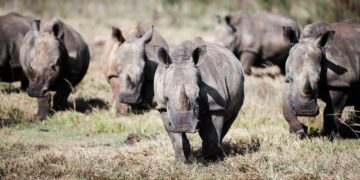By John Ikani
The population of southern white rhinos has experienced its first increase since 2012, according to findings released by the International Union for Conservation of Nature and Natural Resources (IUCN) in their annual survey.
The IUCN’s announcement on Thursday revealed that there are now approximately 16,803 white rhinos, indicating a growth of 5.6% compared to the previous year.
This development is particularly noteworthy as it marks the initial surge in white rhino numbers in nearly a decade.
Simultaneously, the population of black rhinos has also experienced an uptick, reaching nearly 6,500 by the close of the preceding year.
Despite these encouraging numbers, Michael Knight, Chair of the IUCN African Rhino Specialist Group, stressed the need for continued rhino conservation, noting that the threat of poaching persists.
In the year 2022, Africa incurred a loss of 561 rhinos to poaching, with South Africa bearing the brunt of the tragedy, accounting for 448 of these unfortunate deaths.
Notably, poaching incidents in Namibia nearly doubled, surging from 47 rhinos lost in 2021 to 93 in 2022. In contrast, Kenya experienced a decrease in poaching cases, with only one rhino falling victim, compared to six in 2021.
Adding to the conservation efforts, the African Parks conservation group recently acquired the world’s largest private captive rhino breeding operation in South Africa.
As part of their strategy, they plan to reintroduce 2,000 southern white rhinos into their natural habitat.
It is essential to note that only two surviving members of another rhino subspecies, the northern white rhino, exist today.
Both are female and reside in Kenya, a stark reminder of the dire consequences of rhino-horn poaching, which has brought this subspecies to the brink of extinction.


































